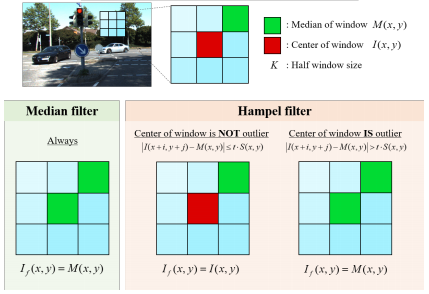
Improvement of Optical Flow Estimation by Using the Hampel Filter for Low-End Embedded Systems
– Published Date : July 2021
– Category : Optical Flow
– Place of publication : IEEE Robotics and Automation Letters (RA-L)
Atstract:
Owing to the recent advances in the field of deeplearning-based approaches, state-of-the-art performance has been achieved for optical flow estimation. However, non-deep-learning based improvement in the optical flow estimation performance is still required because many platforms, such as small UGVs and drones, involve constraints that make mounting GPUs difficult. Thus, in this study, we do not apply deep learning methods; rather, we improve the accuracy of the optical flow pipeline by optimizing only its fundamental parameters. The optical flow estimation performance is influenced by the number of coarse-tofine estimation pyramids, the filter applied to each pyramid level, the window size, and the graduated nonconvexity (GNC) step number. No significant differences from the previous research were achieved by optimizing the parameters heuristically because they have already been optimized. Therefore, we decided to change the filter applied in each pyramid, which is the most important factor in determining the optical flow estimation performance. As a result of verification, the optical flow with the median filter did not show good optical flow estimation performance due to oversmoothing of the image boundary, and the optical flow with the weighted median filter proposed to overcome this drawback could not well address the complexity of the equation and deal with the large computation cost. The proposed Hampel filter shows better performance by minimizing the loss of the original image in the image smoothing process and reduced computational complexity compared to the weighted median filter. The principle of the Hampel filter is similar to that of the median filter, except that if the reference pixel is statistically close to the pixel median in the window, it works by preserving the original pixel value. This is usually used for filtering outliers in a 1D signal but has never been applied for 2D image filters. This study expanded the application of the existing Hampel filter to include 2D images. Compared to the conventional median filter, this filter demonstrates relatively good performance, as it can considerably reduce the loss in the image data and improve the excessive edge smoothing effect such that it can better identify motion. The performance-related improvements achieved by this research were verified using the KITTI Vision Benchmark Suite, and the simulation results demonstrate that the Hampel filter can replace the existing filter and that it has strengths related to multi-object detection, background recognition, and the identification of moving objects at the edges of images.



